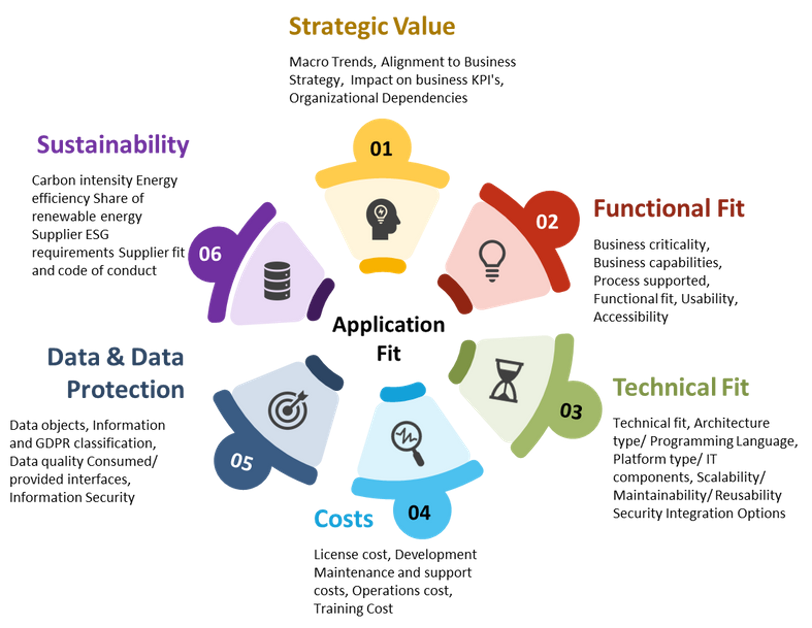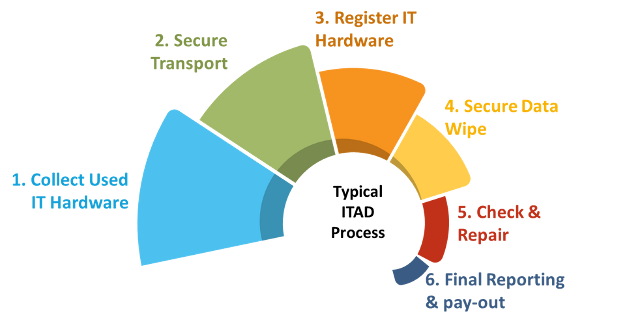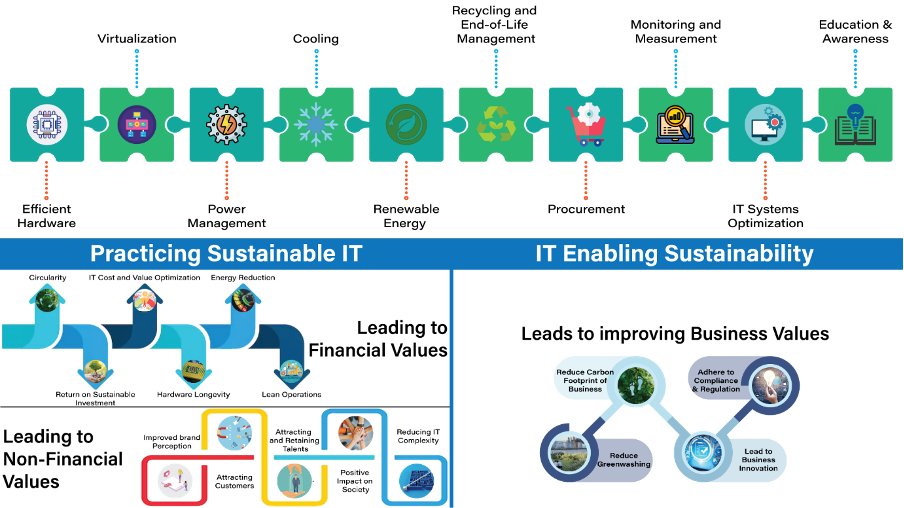· 9 min read
In this article, I try to bring out the need for IT practitioners to be aware and conscious of sustainability. I define what sustainability IT is and then move forward to understand the current situation, thus establishing the need for practicing it, as well as looking at the various puzzle pieces of sustainable IT. Finally, I explore the aspect of enabling sustainability in business through IT.
The ICT sector is often overlooked when it comes to sustainability. However, it is one of the biggest contributors to companies’ carbon footprints. This brings to light the need for sustainable IT. The definition I like is:
“Sustainable IT refers to the practice of designing, using, and disposing of technology in a way that reduces its negative impact on the environment and promotes sustainable development. It involves using technology in a way that is energy-efficient, environmentally responsible, socially beneficial, and economically viable.”
Various surveys provide us with valuable statistics about the topic:
- The information and communication technology (ICT) sector contributes to approximately 4% of global CO2 emissions, comparable to the carbon emissions of the aviation sector. By 2040, projections indicate that the ICT carbon footprint could reach 14%”. – according to the latest report by the IPCC
- The Capgemini survey talks about the footprint of the IT sector. It states that “only 43% of executives are even aware of their organization’s IT Footprint”. “Only 18% have a comprehensive sustainability strategy, with well-defined goals and target timelines”
- The same survey shows a 21% of global electricity consumption is used for the production and operation of ICT and a 20% increase in the production of e-waste in the last five years – 55.5 million tons.
- However, it also shows that – 79% of consumers are changing preferences based on sustainability, and 46% of employees would only work for a company with sustainable practices.
- In the EU alone, more than 160,000 laptops are disposed off every day and 70% of those can be reused.
- A recent report by the IEA found that data center power consumption increased by over 60 percent between 2015 and 2021, and transmission networks' usage grew up to 60 percent.
- A recent report by McKinsey & Co. found that a solar PPA, which enables “100 percent renewable” claims, actually only reduces emissions for the off-taker between 40-50 percent, due to the intermittent availability of solar power.
We can clearly see why we need to focus on practicing sustainable IT. It ensures that businesses are not only sustainable but also resilient and profitable. It requires re-imagining the way of doing business and also designing and managing our systems in a new way. This will require innovative approaches. Some of the areas sustainable IT helps in are:
- Building brand reputation
- Helps in cost-out transformation
- Adhere to compliance
- Innovate
- Better employee engagement
- Perform social responsibility
The puzzle pieces of sustainable IT
Sustainable IT is not just about data centers. As per McKinsey, the largest contributor to carbon emissions within IT is not data centers but rather end-user devices. We need to look at the various elements of the lifecycle as puzzle pieces. We must improve in each of these aspects and look at a more holistic approach than improving in silos. We need to look at the domain, understand how each type of customer is using it, and accordingly work on the hardware, software, and process to achieve improvements through innovation.
Just trying to improve latency and work on the infrastructure to do it is not going to move the needle. We need to re-architect both software and hardware based on customer needs. If the customer's last mile is not good enough for more improved latency, we do not need to put our efforts into improving the service provider end.
The 10 levers for sustainable IT are a set of guidelines that help organizations reduce their environmental impact while still using technology effectively. These levers were developed by the Green Grid, a nonprofit organization focused on improving energy efficiency in data centers. Here are the 10 levers:
- Efficient hardware: organizations can use energy-efficient hardware such as servers, storage devices, and networking equipment to reduce energy consumption and lower their carbon footprint.
- Virtualization: by consolidating multiple physical servers onto a single physical server, organizations can reduce their hardware requirements and energy consumption.
- Power management: organizations can implement power management technologies such as dynamic voltage and frequency scaling, which adjust the power consumption of IT equipment based on workload, to save energy.
- Cooling: efficient cooling systems and best practices for airflow management can reduce energy consumption and improve the efficiency of data centers.
- Renewable energy: organizations can reduce their reliance on fossil fuels by sourcing renewable energy such as wind, solar, and hydropower.
- Recycling and end-of-life management: the proper disposal of electronic waste can reduce the environmental impact of IT equipment.
- Procurement: organizations can choose to purchase IT equipment from vendors that prioritize sustainability and environmental stewardship.
- Monitoring and measurement: monitoring and measuring energy consumption and environmental impact can help organizations identify areas for improvement and track progress over time.
- IT system optimization: ITSM organizations can optimize their IT systems to reduce energy consumption and improve performance.
- Education and awareness: educating employees and stakeholders about the environmental impact of IT and the benefits of sustainability can promote a culture of sustainability within the organization.
Improving IT practices
The current way in which we use IT is causing irreparable effects on the planet. Hence, having greater consideration for the environment, starting from the design of new IT initiatives, will help to balance the pros and cons. We need to be extra careful to understand what benefit we are gaining with how much damage to the planet and then make the decision to go-or-not-go. We should try to reduce negative effects over and above offsetting. Some good practices are the following.
Circularity
We must look at the 9Rs way of thinking. This consists of 0) refuse, 1) rethink, 2) reduce, 3) reuse, 4) repair, 5) refurbish, 6) remanufacture, 7) repurpose, 8) recycle, and lastly 9) recover.
Application portfolio rationalization and management
This practice is essential to meet the SDG Goals. It can be defined as –
“A process that helps organizations optimize their IT investments by analyzing and categorizing their applications based on business value, costs, and technical factors.”
Some of the sustainability opportunities through portfolio rationalization are
- Software license optimization
- Elimination and migration applications to newer technologies
- Simplification technology stack by moving workload from on-premise to cloud
- Reduced maintenance, support, and operations cost
- Virtualization optimization
- Reduction of data storage, including backup and recovery
- Reduce complexity by eliminating redundancies
- Higher energy efficiencies and lower hardware usage
- Platform standardization and next-generation architecture
Current state assessment
We need to start by understanding where we are standing and that requires us to have a proper evaluation process. I recommend using the following steps:

IT asset disposition (ITAD)
This practice focuses on 2 main areas. Firstly, avoid greenhouse gas emissions through responsible recycling, which includes the recycling of critical metals and minerals, and finally diversion of hazardous substances from landfills and improper dispersal. Some of the ITAD services available are:
- Managed deployment
- On or offsite data erasure and destruction
- Asset recovery
- IT asset valuation
- IT asset repurposing or redeployment
- Data center consolidation, migration and decommissioning
- Recycling
- Donation
The following diagram explains how the process usually takes place:

DevSusOps
The term DevSusOps was coined by Adrian Cockcroft. It constitutes the merge of DevSec + Sustainability + Operations = DevSusOps. To be able to practice sustainable IT, we need to practice DevSecOps, site reliability engineering, and platform engineering value stream management together with sustainability in mind. We have to move from digital transformation to sustainable digital transformation.
IT enabling sustainability in business
The convergence of IT in business is very strong. Every business process is IT-enabled. Hence, IT should bring out sustainability-related information directly from the systems.
Individually, each organization can do its part, but there needs to be an ecosystem to really scale sustainability to meet the global objective.
This requires organizations to come together to formulate standards and specifications for sustainability. For example, the first consortium coming out of Github and Thoughtworks is Green Software Foundation (GSF) with the objective to achieve a 45% reduction in GHG emissions by 2030.
The next important aspect is data. Today we do not have enough data and thus it is a challenge to progress. Data sharing has to be more open and data has to be easily accessible to advance the progress of sustainability initiatives. An example of one such initiative is how Ecopetrol, Accenture and AWS came together to create an industry platform enabling participants to share data and create a single source of truth to optimize water management and promote the reuse of water between industries.
Technology needs to be used to create an impact, especially in sustainability. Businesses needs to partner with various technology providers and even startups to innovate and implement greater success in impact to society.
To make the sustainable digital transformation happen, we need the following key considerations:
- Top leadership commitment and sustainability to be part of their performance management through OKRs
- Funding
- Capabilities need to be built through a process of awareness, consciousness and enablement
- Continuous innovation through continuous learning and experimentation
- Sustainability-oriented people and culture
Final thoughts
While we are going to use technology for nearly everything, we have to use technology in a sustainable manner. In summary, we can say that sustainable IT should be practiced as below:

IT practitioners cannot ignore the sustainability movement. They must practice sustainable IT and enable sustainability in business.
illuminem Voices is a democratic space presenting the thoughts and opinions of leading Sustainability & Energy writers, their opinions do not necessarily represent those of illuminem.






